2012 FORD SUPER DUTY parking brake
[x] Cancel search: parking brakePage 8 of 93
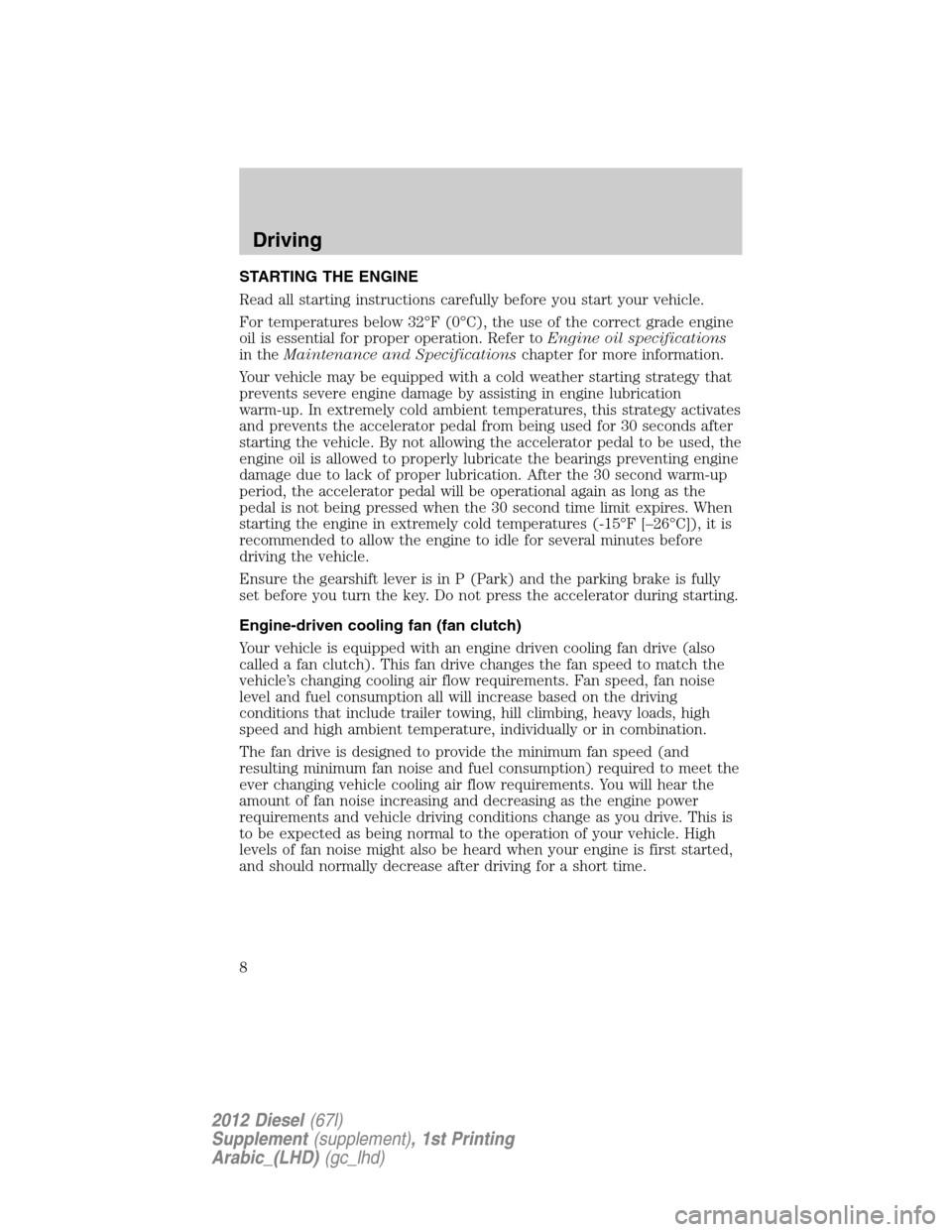
STARTING THE ENGINE
Read all starting instructions carefully before you start your vehicle.
For temperatures below 32°F (0°C), the use of the correct grade engine
oil is essential for proper operation. Refer toEngine oil specifications
in theMaintenance and Specificationschapter for more information.
Your vehicle may be equipped with a cold weather starting strategy that
prevents severe engine damage by assisting in engine lubrication
warm-up. In extremely cold ambient temperatures, this strategy activates
and prevents the accelerator pedal from being used for 30 seconds after
starting the vehicle. By not allowing the accelerator pedal to be used, the
engine oil is allowed to properly lubricate the bearings preventing engine
damage due to lack of proper lubrication. After the 30 second warm-up
period, the accelerator pedal will be operational again as long as the
pedal is not being pressed when the 30 second time limit expires. When
starting the engine in extremely cold temperatures (-15°F [–26°C]), it is
recommended to allow the engine to idle for several minutes before
driving the vehicle.
Ensure the gearshift lever is in P (Park) and the parking brake is fully
set before you turn the key. Do not press the accelerator during starting.
Engine-driven cooling fan (fan clutch)
Your vehicle is equipped with an engine driven cooling fan drive (also
called a fan clutch). This fan drive changes the fan speed to match the
vehicle’s changing cooling air flow requirements. Fan speed, fan noise
level and fuel consumption all will increase based on the driving
conditions that include trailer towing, hill climbing, heavy loads, high
speed and high ambient temperature, individually or in combination.
The fan drive is designed to provide the minimum fan speed (and
resulting minimum fan noise and fuel consumption) required to meet the
ever changing vehicle cooling air flow requirements. You will hear the
amount of fan noise increasing and decreasing as the engine power
requirements and vehicle driving conditions change as you drive. This is
to be expected as being normal to the operation of your vehicle. High
levels of fan noise might also be heard when your engine is first started,
and should normally decrease after driving for a short time.
Driving
8
2012 Diesel(67l)
Supplement(supplement), 1st Printing
Arabic_(LHD)(gc_lhd)
Page 10 of 93
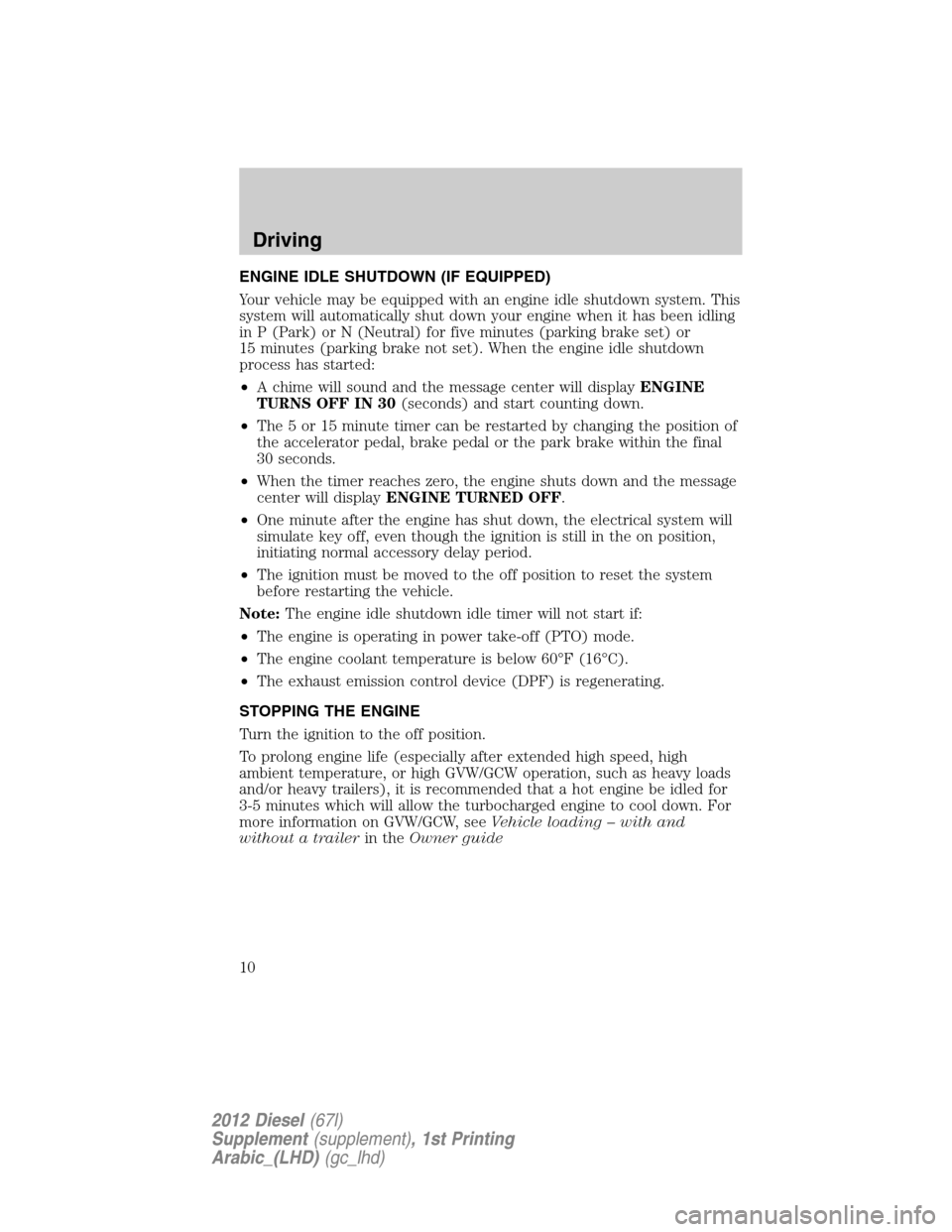
ENGINE IDLE SHUTDOWN (IF EQUIPPED)
Your vehicle may be equipped with an engine idle shutdown system. This
system will automatically shut down your engine when it has been idling
in P (Park) or N (Neutral) for five minutes (parking brake set) or
15 minutes (parking brake not set). When the engine idle shutdown
process has started:
•A chime will sound and the message center will displayENGINE
TURNS OFF IN 30(seconds) and start counting down.
•The 5 or 15 minute timer can be restarted by changing the position of
the accelerator pedal, brake pedal or the park brake within the final
30 seconds.
•When the timer reaches zero, the engine shuts down and the message
center will displayENGINE TURNED OFF.
•One minute after the engine has shut down, the electrical system will
simulate key off, even though the ignition is still in the on position,
initiating normal accessory delay period.
•The ignition must be moved to the off position to reset the system
before restarting the vehicle.
Note:The engine idle shutdown idle timer will not start if:
•The engine is operating in power take-off (PTO) mode.
•The engine coolant temperature is below 60°F (16°C).
•The exhaust emission control device (DPF) is regenerating.
STOPPING THE ENGINE
Turn the ignition to the off position.
To prolong engine life (especially after extended high speed, high
ambient temperature, or high GVW/GCW operation, such as heavy loads
and/or heavy trailers), it is recommended that a hot engine be idled for
3-5 minutes which will allow the turbocharged engine to cool down. For
more information on GVW/GCW, seeVehicle loading – with and
without a trailerin theOwner guide
Driving
10
2012 Diesel(67l)
Supplement(supplement), 1st Printing
Arabic_(LHD)(gc_lhd)
Page 29 of 93
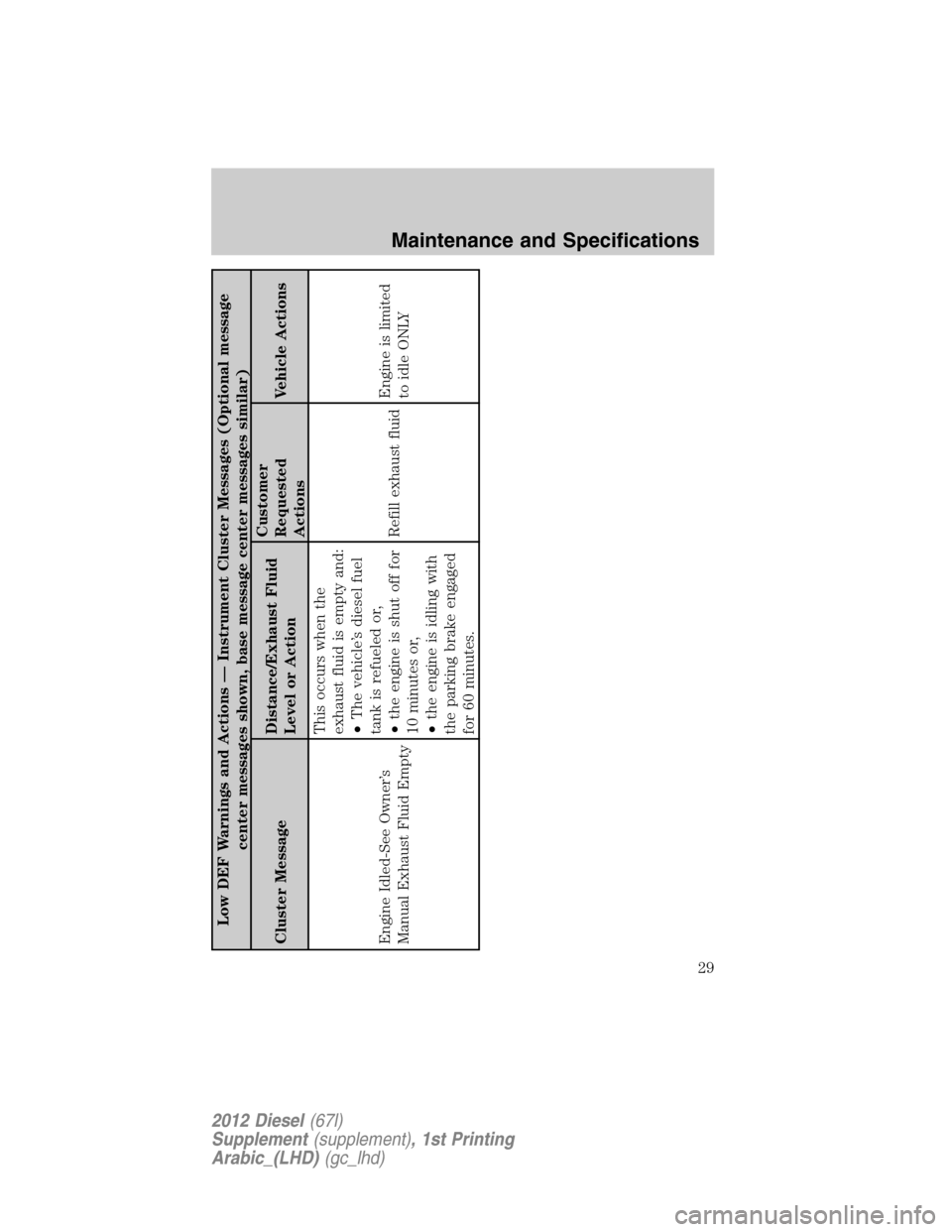
Low DEF Warnings and Actions — Instrument Cluster Messages (Optional message
center messages shown, base message center messages similar)
Cluster MessageDistance/Exhaust Fluid
Level or ActionCustomer
Requested
ActionsVehicle Actions
Engine Idled-See Owner’s
Manual Exhaust Fluid EmptyThis occurs when the
exhaust fluid is empty and:
•The vehicle’s diesel fuel
tank is refueled or,
•the engine is shut off for
10 minutes or,
•the engine is idling with
the parking brake engaged
for 60 minutes.Refill exhaust fluidEngine is limited
to idle ONLY
Maintenance and Specifications
29
2012 Diesel(67l)
Supplement(supplement), 1st Printing
Arabic_(LHD)(gc_lhd)
Page 56 of 93
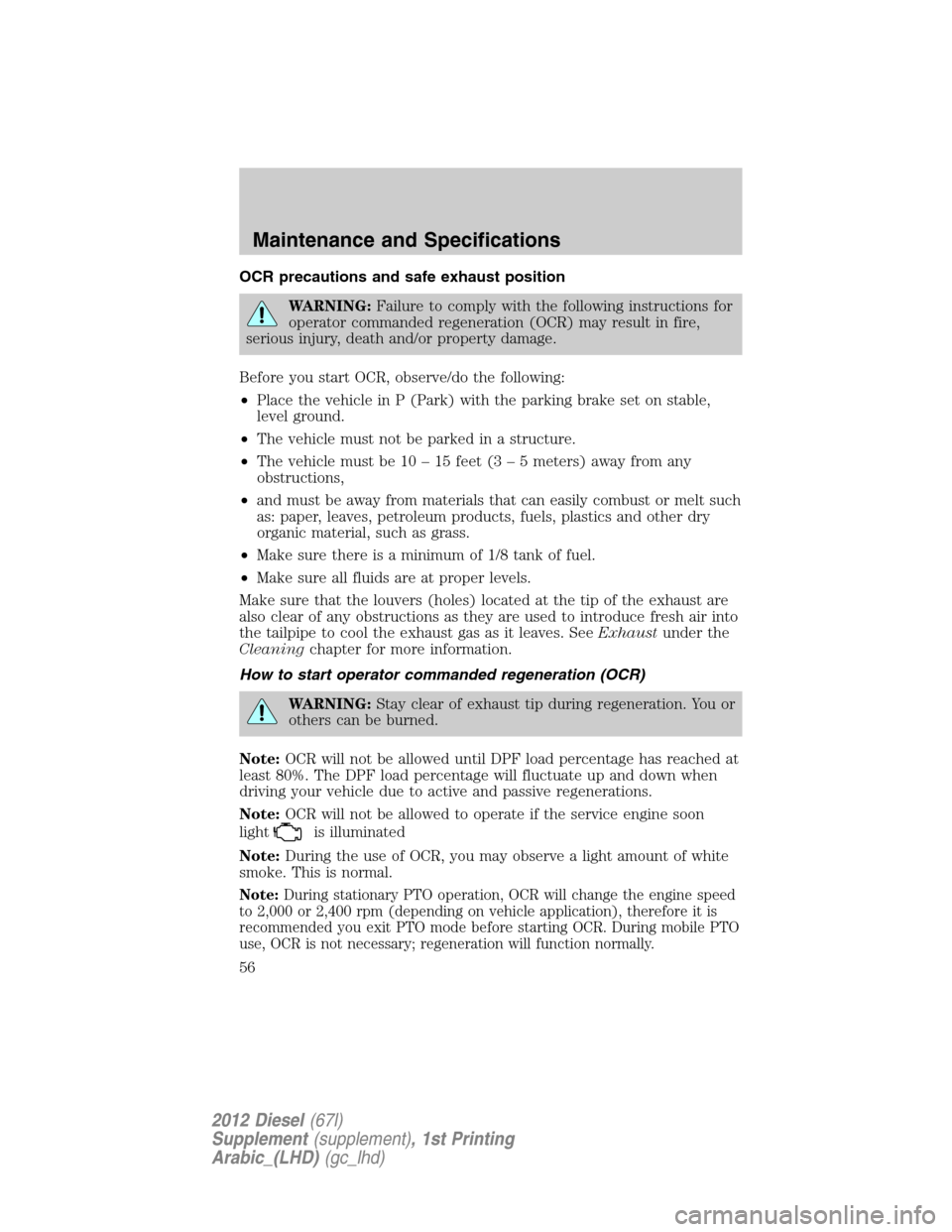
OCR precautions and safe exhaust position
WARNING:Failure to comply with the following instructions for
operator commanded regeneration (OCR) may result in fire,
serious injury, death and/or property damage.
Before you start OCR, observe/do the following:
•Place the vehicle in P (Park) with the parking brake set on stable,
level ground.
•The vehicle must not be parked in a structure.
•The vehicle must be 10 – 15 feet (3 – 5 meters) away from any
obstructions,
•and must be away from materials that can easily combust or melt such
as: paper, leaves, petroleum products, fuels, plastics and other dry
organic material, such as grass.
•Make sure there is a minimum of 1/8 tank of fuel.
•Make sure all fluids are at proper levels.
Make sure that the louvers (holes) located at the tip of the exhaust are
also clear of any obstructions as they are used to introduce fresh air into
the tailpipe to cool the exhaust gas as it leaves. SeeExhaustunder the
Cleaningchapter for more information.
How to start operator commanded regeneration (OCR)
WARNING:Stay clear of exhaust tip during regeneration. You or
others can be burned.
Note:OCR will not be allowed until DPF load percentage has reached at
least 80%. The DPF load percentage will fluctuate up and down when
driving your vehicle due to active and passive regenerations.
Note:OCR will not be allowed to operate if the service engine soon
light
is illuminated
Note:During the use of OCR, you may observe a light amount of white
smoke. This is normal.
Note:During stationary PTO operation, OCR will change the engine speed
to 2,000 or 2,400 rpm (depending on vehicle application), therefore it is
recommended you exit PTO mode before starting OCR. During mobile PTO
use, OCR is not necessary; regeneration will function normally.
Maintenance and Specifications
56
2012 Diesel(67l)
Supplement(supplement), 1st Printing
Arabic_(LHD)(gc_lhd)
Page 74 of 93
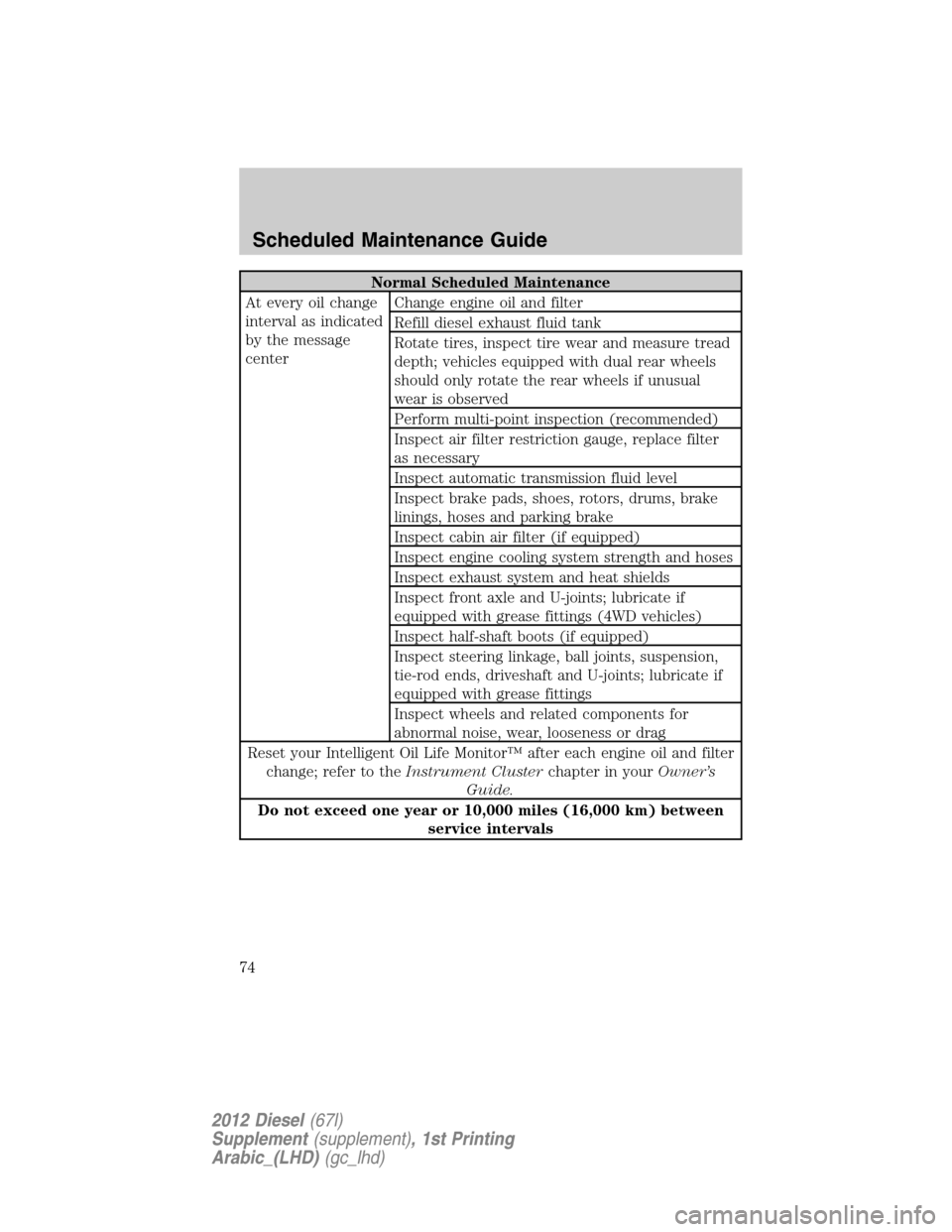
Normal Scheduled Maintenance
At every oil change
interval as indicated
by the message
centerChange engine oil and filter
Refill diesel exhaust fluid tank
Rotate tires, inspect tire wear and measure tread
depth; vehicles equipped with dual rear wheels
should only rotate the rear wheels if unusual
wear is observed
Perform multi-point inspection (recommended)
Inspect air filter restriction gauge, replace filter
as necessary
Inspect automatic transmission fluid level
Inspect brake pads, shoes, rotors, drums, brake
linings, hoses and parking brake
Inspect cabin air filter (if equipped)
Inspect engine cooling system strength and hoses
Inspect exhaust system and heat shields
Inspect front axle and U-joints; lubricate if
equipped with grease fittings (4WD vehicles)
Inspect half-shaft boots (if equipped)
Inspect steering linkage, ball joints, suspension,
tie-rod ends, driveshaft and U-joints; lubricate if
equipped with grease fittings
Inspect wheels and related components for
abnormal noise, wear, looseness or drag
Reset your Intelligent Oil Life Monitor™ after each engine oil and filter
change; refer to theInstrument Clusterchapter in yourOwner’s
Guide.
Do not exceed one year or 10,000 miles (16,000 km) between
service intervals
Scheduled Maintenance Guide
74
2012 Diesel(67l)
Supplement(supplement), 1st Printing
Arabic_(LHD)(gc_lhd)